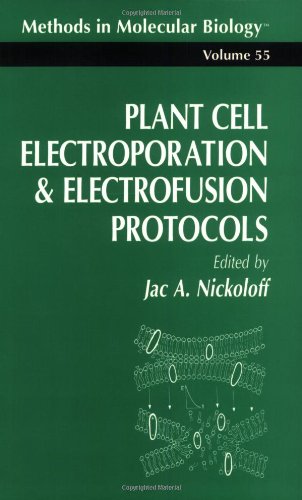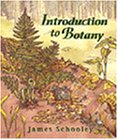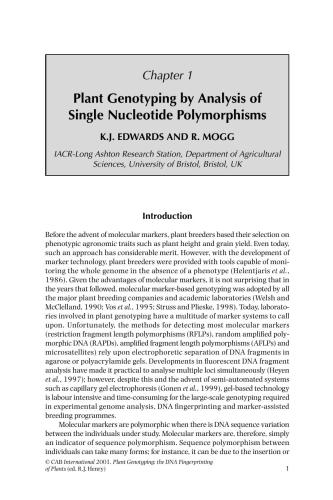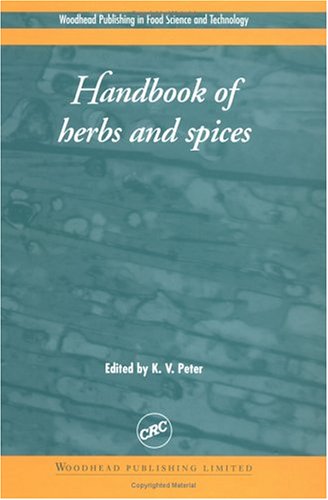Colin Turnbull, Science9781405121286, 1405121289
Table of contents :
Plant Architecture and its Manipulation……Page 3
Contents……Page 5
Contributors……Page 11
Preface……Page 13
1.2 Growth and cell proliferation are related but separable components controlling cellular architecture……Page 15
1.3 Meristems as a source of cells in the plant……Page 17
1.4 Patterning of cellular architecture……Page 20
1.5 The cellular decision to proliferate or not to proliferate……Page 22
1.6 The cytoskeleton as an intermediary in the regulation of cellular architecture……Page 25
1.7.1 The relationship between cell architecture and organ size and shape……Page 29
1.7.2 Cell division and organ initiation……Page 31
1.7.3 Coordination of organ initiation……Page 32
1.8 Conclusions……Page 33
2.1 Introduction……Page 37
2.2 Phyllotaxis……Page 38
2.2.2 Regulation of phyllotaxis……Page 40
2.3.1 Role of expansin in leaf initiation……Page 43
2.4 Development of leaf symmetry……Page 44
2.4.1 Adaxial domain……Page 45
2.5.1 Dicots……Page 47
2.5.2 Monocots……Page 48
2.6 Development of compound leaf architecture……Page 49
2.6.1.2 Phantastica……Page 52
2.6.1.3 Floricaula, Leafy, Unifoliata and Falsiflora……Page 53
2.7 Leaf expansion……Page 55
2.8 Development of internal leaf architecture……Page 57
2.8.1 Cell division and tissue patterning……Page 58
2.8.2 Vascular pattern formation……Page 59
2.8.3 Epidermal cell pattern……Page 60
2.8.3.1 Stomate pattern……Page 61
2.9 Concluding remarks……Page 62
3.2.1 Auxin, gibberellin and brassinosteroid……Page 71
3.3 Hormone signal transduction……Page 79
3.4 Dwarfism not mediated by hormones……Page 80
3.5 The green revolution……Page 81
3.6 Interactions between hormones……Page 84
3.7.1 Effects of light on stem growth……Page 87
3.7.1.1 De-etiolation……Page 88
3.7.1.2 Shade-avoidance……Page 90
3.7.2 Mediation of light effects by hormones……Page 92
3.7.3 Effects of other factors, including flooding and decapitation/grazing……Page 97
3.8 Concluding discussion – are hormones regulators of plant growth or merely permissive factors?……Page 98
4.1.1 Species differ widely in propensity for branching during normal ontogeny……Page 106
4.1.2 Responses to decapitation……Page 107
4.2.1 Developmental zones……Page 109
4.2.2 Shoot dimorphism: orthotropic vs. plagiotropic development……Page 110
4.2.3 Relative timing: proleptic vs. sylleptic branching……Page 112
4.2.4 Reiteration: monopodial vs. sympodial systems……Page 113
4.3 Bud initiation……Page 115
4.3.1.2 Blind (Bl)……Page 117
4.3.1.5 SAX loci……Page 118
4.4 Bud dormancy and branch outgrowth……Page 119
4.4.1 Branch outgrowth genes……Page 120
4.4.2 Physiology of branching mutants……Page 121
4.4.3 Shoot branching and apical dominance models……Page 124
4.4.4 Branching control: more than auxin and cytokinin……Page 126
4.5.1.1 Photoperiod……Page 127
4.5.2 Nutrition……Page 128
4.6 Conclusions and prospects……Page 129
5.2 Phyllotaxy and merosity……Page 135
5.2.1 Genetic control of floral phyllotaxy……Page 137
5.2.2 Genetic control of merosity……Page 138
5.2.3 Evolutionary aspects of phyllotaxy and merosity……Page 139
5.3 Floral symmetry……Page 140
5.3.1 Genetic control of floral symmetry……Page 141
5.3.2 Evolutionary aspects of floral symmetry……Page 142
5.4.1 Genetic control of floral organ identity……Page 144
5.4.2 Evolutionary aspects of floral organ identity……Page 147
5.4.2.1 Patterns of gene duplication and their functional significance……Page 148
5.4.2.2 Patterns of gene expression and their morphological significance……Page 150
5.5 Elaboration of organ identity……Page 152
5.6 Sex determination as a modification of floral architecture……Page 153
5.7 Future perspectives……Page 154
6.1 Determinate and indeterminate inflorescence types……Page 163
6.2.1 Simple inflorescences……Page 164
6.3 Growth and branching patterns of shoots……Page 166
6.4 Vegetative to reproductive transition……Page 168
6.5.1 Shoot/inflorescence meristem identity……Page 169
6.5.2 Flower meristem identity genes……Page 170
6.6.1 Maize inflorescence development……Page 171
6.6.2 Pea mutants……Page 177
6.6.3 Tomato inflorescence development……Page 179
6.6.4 Petunia inflorescence development……Page 180
6.6.5 Capitulum development……Page 182
6.6.6 Arabidopsis inflorescence development……Page 183
6.7 Evolution of inflorescence architecture……Page 188
7.1 Introduction – an evolutionary perspective……Page 196
7.2.1 Taproot systems……Page 197
7.2.2 Fibrous root systems……Page 198
7.2.4 Food storage roots……Page 200
7.3.1 Embryonic root development……Page 201
7.3.1.1 Auxin regulation of embryonic root development……Page 202
7.4.1 Primary root tip……Page 203
7.4.2 Internal root structure……Page 205
7.5.1 Root hairs……Page 207
7.5.2 Lateral roots……Page 209
7.5.2.1 Role of auxin in lateral root development……Page 210
7.6 Regulation of root system architecture by nutrient signals……Page 211
7.6.1 Effects of nutrient availability on root hair formation……Page 212
7.6.2 Effects of nutrient availability on root branching……Page 213
7.6.3.1 Phosphatidic acid……Page 214
7.6.3.2 Alkamides and N-acylethanolamines……Page 215
7.7 Mutualistic associations between roots and soil microorganisms……Page 216
7.7.1 Signaling in plant–microbe interactions……Page 217
7.8 Conclusions……Page 219
8.1 Introduction……Page 223
8.2.1 Vascular differentiation……Page 226
8.2.2 Radial patterns……Page 227
8.2.3 Ecotypes……Page 228
8.3.1 Apical dominance……Page 231
8.3.3 Leaf vs. wood allocation……Page 232
8.3.4 Stability……Page 234
8.4.1 Architectural tree models……Page 235
8.4.2 Tree dimensions……Page 238
8.5 Intra-specific patterns……Page 239
8.6 Within-tree patterns……Page 240
8.7 Applications in forestry……Page 242
8.8 Conclusions……Page 244
9.1 Introduction……Page 252
9.2.1 Meristem activity and phyllotaxy……Page 253
9.2.2 Differentiation of axes……Page 254
9.2.3 Architectural gradients……Page 255
9.3.1 Representing plants as graphs……Page 256
9.3.2 Coding plant architecture……Page 259
9.3.3 3-D Digitizing……Page 260
9.3.4.1 Looking for remarkable variations of positional information……Page 262
9.3.4.2 Analysing spatial or temporal series……Page 263
9.3.4.3 The fractal nature of plants……Page 268
9.4.1 Models of plant–environment interaction……Page 270
9.4.1.1 Light capture……Page 271
9.4.1.3 Momentum transfer……Page 274
9.4.1.5 Accounting for gravity……Page 275
9.5.1 Dynamic systems with dynamic structure……Page 277
9.5.1.1 Specific approaches……Page 278
9.5.1.2 Generic approaches: towards the definition of languages for morphogenesis……Page 279
9.5.2.1 Bottom–up geometric approaches……Page 281
9.5.2.2 Top–down geometric approaches……Page 285
9.5.3 Reactive models……Page 287
9.5.3.1 Management of fluxes……Page 288
9.5.3.2 Reaction to the environment……Page 289
9.5.3.3 Integrated reactive models……Page 291
9.6 Conclusion and perspectives……Page 292
Hors-d’oeuvre: tender asparagus in melted lemon and Parmesan butter……Page 302
The wine list……Page 304
Starter: rosemary and Taleggio stuffed tomatoes on a bed of herbs……Page 310
Main course: pea and Pecorino risotto with saffron……Page 312
Dessert: individual apple tarts with strawberry coulis……Page 314
Coffee served with Deglet Noor……Page 318
Index……Page 329







Reviews
There are no reviews yet.